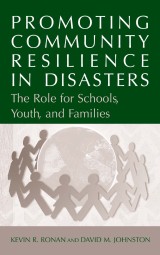Details

Promoting Community Resilience in Disasters
The Role for Schools, Youth, and Families|
96,29 € |
|
| Verlag: | Springer |
| Format: | |
| Veröffentl.: | 30.05.2006 |
| ISBN/EAN: | 9780387238210 |
| Sprache: | englisch |
| Anzahl Seiten: | 210 |
Dieses eBook enthält ein Wasserzeichen.
Beschreibungen
A myriad of models are available to guide practice before, during, and following disasters. As emphasized in this book, we value the role of research in informing our assessment, education, and intervention efforts in this area. Keeping an eye on those elements that have research backing certainly assists with quality control generally. However, more specifically, we also stress the idea that there is evidence to support a role for hope and positive expectations in the motivation and engagement process. In addition, the more that people, including youth and adults, actively participate in efforts designed to help, the more benefits they tend to receive. The role of research in providing that initial hope and inspiring more active engagement with internal and external resources before, during, and after a disaster is part of the foundation of our practice in this area. In fact, in the clinical psychology training program directed by the senior author, the idea that we attempt to inculcate with our trainees is the idea of “hope and engagement on an evidence-based foundation.” Consequently, we do advocate for models of practice that have identified “active ingredients” that are included: those particularly identified through controlled evaluation research. However, it is also the case that a number of risk and protective factors identified through a number of studies (e.g., see Chapter 2) have as yet to be systematically included.
<P>Introduction to a Community Resilience Framework.- Community Resilience to Disasters: Introduction to Theory and Review of Research.- Community Resilience: The Role for Schools, Youth and Families.- Community Resilience: A Partnership and Multidisciplinary Perspective.- Promoting Resilience: Readiness and Risk Reduction.- Promoting Resilience: Response.- Promoting Resilience: Recovery.- Putting It All Together: Evidence Based Guidelines for Practice.- The Research-Practice Interface and Recommendations.- Appendices.- References.- Index.</P>
<p>Kevin Ronan has been working in the hazards and disasters area for the past decade. He has an ongoing interest in community resilience and prevention work in this and other areas (e.g., conduct disorder and delinquency in youth and families). He has been the Director of Clinical Psychology Training at Massey University for a number of years and stresses evidence-based practice with trainees. In addition, the idea of accountability for producing outcomes is an emphasis in the training program and in his practice. He has published widely in the area of hazards and disasters. </p><p>David Johnston has been employed with the Institute of Geological and Nuclear Sciences, New Zealand since 1993 and his research is focused on reducing the vulnerability of society, economy and infrastructure to hazards. He has been involved in developing integrated risk management strategies for different hazard events, using techniques such as scenario development, mitigation planning and community education programs. He is also interested in assessing social and economic impacts of natural and environmental hazard events.</p>
<p>Although there are several books published on trauma and adjustment to trauma, there are no books to date that focus on schools and other related community-based networks as gateways to assisting children and families to prepare for and to cope with a large scale event</p>
<P>Although many books discuss trauma and adjustment to trauma, this is the first reference to focus on schools and other related community-based networks as gateways to assisting children and families to prepare for and to cope with a large scale disaster. The text assesses risk and readiness as well as active education programs for schools, children, and families, the public at large, and organizations and government. Drawing on a multidisciplinary framework, this volume promotes community resilience and readiness, response and recovery.</P>

















